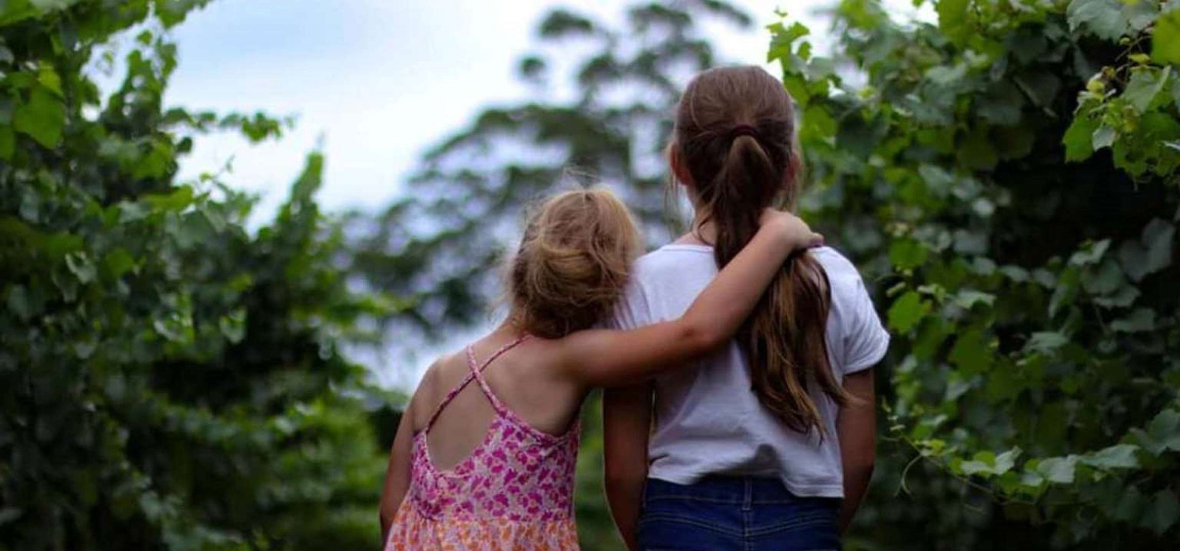
Mary Pedersen reflects on the ways God reveals His mysteries to the little ones.
After hiking the path, we were delighted to discover a stone bench. Like books crammed on the shelf, the five of us squeezed together to rest. When 2-year-old Aubree’s blonde curls ceased bouncing, my friend, Aubree’s grandmother, coaxed her gently, “Listen to the breeze. What do you think the breeze is trying to say to you?” Aubree shut her eyes tightly, cupped her right ear with her dimpled hand, and listened with all her might to the whisperings of the air.
When my 10-year-old twin granddaughters stopped giggling at Aubree, they fell silent, lifted their faces to the sky, and listened intently. After a moment, my friend continued, “We must be quiet to hear the breeze — to hear the voice of God.” Though we had trekked along a rocky path, our granddaughters’ hearts were fertile ground for receiving good seed. God speaks through the breeze — for those who have ears to hear.
A recent Sunday’s readings reflect on parables, mysteries, paths, seeds, rocks, thorns, fertile ground, and fruit. The seed is the Word of God and depending upon the condition of the soul, the seed either produces faith or remains barren. As parents and grandparents, we are the ones primarily responsible for preparing and tending the hearts of our children to receive the seed — the proclamation. In The Religious Potential of the Child, author Sofia Cavalletti insists the young child already has a relationship with God at a “deep, existential level. ... The child is really capable of listening impartially and unselfishly, and so the child is receptive (of receiving God’s Word) to the greatest degree.”
The 2-year-old views the world with awe and wonder, interested in each created thing from the ladybug to the stars. Ours is to proclaim God’s creative presence in the hard-shelled red bug and to give God glory for the brilliant night-lights. A 10-year-old seeks safety and we name grace — God’s protective presence — by assuring them of shelter in the middle of the night. Though teens may act ambivalent, we speak of God’s guiding presence as they search for meaning and acceptance.
Interestingly, as adults, ours is to become more like children, for God reveals the mysteries to the little ones—to those who have ears to hear and eyes to see. William Barry, SJ, encourages us to grow in our relationship with the Divine by Paying Attention to God. Do we hear — really hear — God’s voice? In the silence? In His Word? In the poor? In the breeze? Do we see — really see — God’s handiwork? In creation? In our children? In the elderly? In the suffering?
In A Book About God, Florence Mary Fitch helps children (and adults) to understand God’s presence everywhere — even in the breeze, for those who have eyes and for those who have ears:
“The air is
like God ...
Air is all around us.
Even though we do not see it
we feel its warmth
and its coolness.”
As with any crop, we must faithfully water, weed, and fertilize our children and grandchildren’s faith, but it is Jesus who sows the seed. And though grown children, of even the most faithful parents, have not yet born fruit, we wisely remember the promise from the prophet Isaiah: “my word shall not return to me void, but shall do my will, achieving the end for which I sent it.” God is faithful. Now, that’s good news!
How have helped your child to listen to the voice of God? When have you “seen” or “heard” differently?
How have helped your child to listen to the voice of God? #catholicmom
Copyright 2020 Mary Pedersen
Image: Pixabay (2017)
About the Author

Mary Pedersen
Mary Pedersen serves as "first preacher" to six and grand-preacher to ten! She holds a doctorate in preaching from the Aquinas Institute of Theology, with her thesis, "Parents as First Preachers: Naming Grace in the Domestic Church." She writes and speaks on topics of faith and family, and has been known on probably far too many occasions, to shout out a woo-hoo! Mary blogs at MaryPedersen.com.


.png?width=1806&height=731&name=CatholicMom_hcfm_logo1_pos_871c_2728c%20(002).png)
Comments